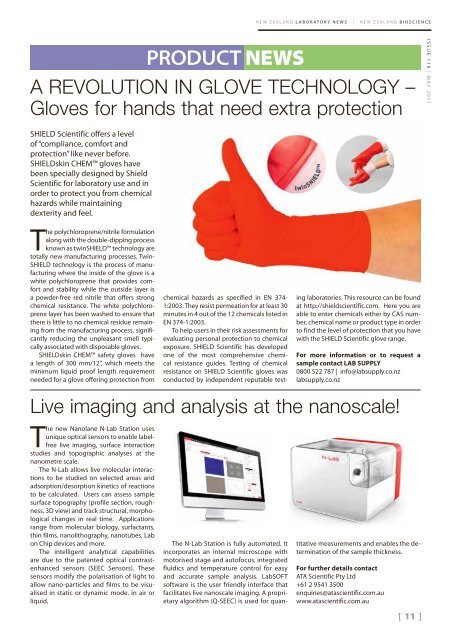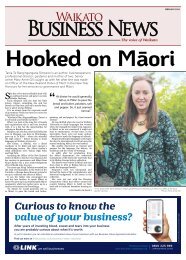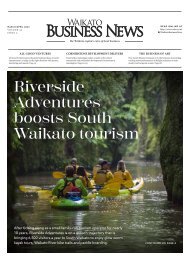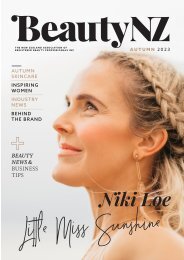Laboratory News & BioScience May 2017
New Zealand's leading scientific publication for more than 20 years. This bi-monthly magazine provides the latest up to date information on new products and services to a readership which is carefully targeted and updated on a regular basis.
New Zealand's leading scientific publication for more than 20 years. This bi-monthly magazine provides the latest up to date information on new products and services to a readership which is carefully targeted and updated on a regular basis.
- No tags were found...
You also want an ePaper? Increase the reach of your titles
YUMPU automatically turns print PDFs into web optimized ePapers that Google loves.
NEW ZEALAND LABORATORY NEWS | NEW ZEALAND BIOSCIENCE<br />
PRODUCT NEWS<br />
A REVOLUTION IN GLOVE TECHNOLOGY –<br />
Gloves for hands that need extra protection<br />
ISSUE 118 | MAY <strong>2017</strong><br />
SHIELD Scientific offers a level<br />
of “compliance, comfort and<br />
protection” like never before.<br />
SHIELDskin CHEM gloves have<br />
been specially designed by Shield<br />
Scientific for laboratory use and in<br />
order to protect you from chemical<br />
hazards while maintaining<br />
dexterity and feel.<br />
The polychloroprene/nitrile formulation<br />
along with the double-dipping process<br />
known as twinSHIELD technology are<br />
totally new manufacturing processes. Twin-<br />
SHIELD technology is the process of manufacturing<br />
where the inside of the glove is a<br />
white polychloroprene that provides comfort<br />
and stability while the outside layer is<br />
a powder-free red nitrile that offers strong<br />
chemical resistance. The white polychloroprene<br />
layer has been washed to ensure that<br />
there is little to no chemical residue remaining<br />
from the manufacturing process, significantly<br />
reducing the unpleasant smell typically<br />
associated with disposable gloves.<br />
SHIELDskin CHEM safety gloves have<br />
a length of 300 mm/12”, which meets the<br />
minimum liquid proof length requirement<br />
needed for a glove offering protection from<br />
chemical hazards as specified in EN 374-<br />
1:2003. They resist permeation for at least 30<br />
minutes in 4 out of the 12 chemicals listed in<br />
EN 374-1:2003.<br />
To help users in their risk assessments for<br />
evaluating personal protection to chemical<br />
exposure, SHIELD Scientific has developed<br />
one of the most comprehensive chemical<br />
resistance guides. Testing of chemical<br />
resistance on SHIELD Scientific gloves was<br />
conducted by independent reputable testing<br />
laboratories. This resource can be found<br />
at http://shieldscientific.com. Here you are<br />
able to enter chemicals either by CAS number,<br />
chemical name or product type in order<br />
to find the level of protection that you have<br />
with the SHIELD Scientific glove range.<br />
For more information or to request a<br />
sample contact LAB SUPPLY<br />
0800 522 787 | info@labsupply.co.nz<br />
labsupply.co.nz<br />
Live imaging and analysis at the nanoscale!<br />
The new Nanolane N-Lab Station uses<br />
unique optical sensors to enable labelfree<br />
live imaging, surface interaction<br />
studies and topographic analyses at the<br />
nanometre scale.<br />
The N-Lab allows live molecular interactions<br />
to be studied on selected areas and<br />
adsorption/desorption kinetics of reactions<br />
to be calculated. Users can assess sample<br />
surface topography (profile section, roughness,<br />
3D view) and track structural, morphological<br />
changes in real time. Applications<br />
range from molecular biology, surfactants,<br />
thin films, nanolithography, nanotubes, Lab<br />
on Chip devices and more.<br />
The intelligent analytical capabilities<br />
are due to the patented optical contrastenhanced<br />
sensors (SEEC Sensors). These<br />
sensors modify the polarisation of light to<br />
allow nano-particles and films to be visualised<br />
in static or dynamic mode, in air or<br />
liquid.<br />
The N-Lab Station is fully automated. It<br />
incorporates an internal microscope with<br />
motorised stage and autofocus, integrated<br />
fluidics and temperature control for easy<br />
and accurate sample analysis. LabSOFT<br />
software is the user friendly interface that<br />
facilitates live nanoscale imaging. A proprietary<br />
algorithm (Q-SEEC) is used for quantitative<br />
measurements and enables the determination<br />
of the sample thickness.<br />
For further details contact<br />
ATA Scientific Pty Ltd<br />
+61 2 9541 3500<br />
enquiries@atascientific.com.au<br />
www.atascientific.com.au<br />
[ 11 ]


















